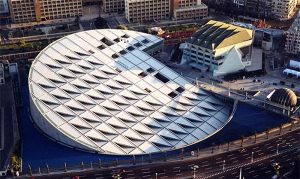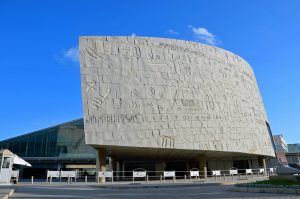An academic library is more than a repository of books or a place to work; it reflects its community and their hopes, dreams, and ambitions.
-Michael Stephens
Academic libraries continuously evolve to remain at the forefront of education and research trends to unite people with similar intents worldwide. This requires an active and dynamic use of space, intentional choices for creative and relevant tools and services, and consideration of how communication and information sharing are taking place. Today’s institutions are “interdisciplinary waypoints” that provide technology-rich, flexible, and competitive information services for students, faculty, and researchers (NC State, 2013). These library users are tasked to work more collaboratively than ever before and utilize a wide range of digital resources and technology in producing their projects. Academic librarians guide them through the vast informational landscape of scholarly literature and research, delivering the best storage, access, and discoverability technological strategies. This also accounts for the information-seeking behavior of the modern student and researcher, who prefers not to interact directly with librarians or physical collections and a hybrid setting of physical and digital resources and study spaces (LSE Impact Blog, 2017).
An exciting example of the metamorphosis of the academic library over time is the revival of the Library of Alexandria. The Bibliotheca Alexandrina is a modern library conceived in 1974 and opened in 2002 in Alexandria, Egypt, sitting approximately on the same site the original library is believed to have been. The project’s vision was to resurrect the legacy of the Ancient Library of Alexandria, considered the ancient world’s first and greatest scholarly library (Fineberg, 2006). The new library needed to simultaneously represent the intellectual ideals of the past and embody the finest academic pursuits of the modern age. The project’s stakeholders and designers had to grapple with the concerns of any modern information institution, such as justifying building a library to hold eight million books when printed materials are less relevant and how to design the material space of a timeless library environment for the Internet age (Stille, 2000).
The library’s architectural design reflects the project’s objectives to revive and modernize an aspect of cultural heritage without simply reconstructing a historical monument. The building design aimed “to bear witness to the deep roots of Egyptian civilization and a pearl in the crown of the culture of tomorrow.” The final design is crafted as an inclined cylinder to evoke the sun and reflect light, like scholars reflecting light onto knowledge. A large granite wall is covered in sculpted symbols reminiscent of letters from the world’s many alphabets to evoke its role as a universal exchange center for knowledge between cultures worldwide (Ministry of Culture, 2003). The building is topped with a large circle resembling a microchip, an homage to its past as the “container of all the eastern worlds’ knowledge” while conveying its modernity’s conductive, active element. The physical appearance of the new library is not meant to mirror the ancient library literally but to symbolically honor their common ambitions to be more than a repository for books and attract scholars from all disciplines to debate, discover, and innovate knowledge (Journeyman Pictures, 2018).


The interior design of the information environment balances the needs of a modern academic library while still honoring the legacy of the ancient institution. The Ancient Library of Alexandria accommodated half a million papyrus scrolls, the largest collection of written knowledge at the time. The stakeholders for the revival felt it was essential that the modern library have a robust digital collection but specialize in large physical collections focused on Mediterranean cultures and rare manuscripts to honor the traditional ideals of progress, enlightenment, and freedom of expression (Journeyman Pictures, 2018). Like the ancient structure, the library is vast and includes many ancillary areas for various pursuits, like conference halls, observatories, and refectories. The modern library has added a documentation and research center, a library for the blind, a children’s library, an exhibition of manuscripts, and an exhibition of calligraphy, maps, and photography. Expanded areas for scientific and educational programs include a science museum, an astronomical research unit, restoration laboratories, and an archeological museum. As of 2003, the library housed one and a half million physical books and the best digital and computerized tools available at the time (Ministry of Culture, 2003).
The greatest example of the Bibliotheca Alexandrina honoring the mission of the Ancient Library through cultural adaptation is its contributions to the World Digital Library. The ancient library was known for its function as a vital connection for educational and cultural exchanges between Egypt and the rest of the Mediterranean. To contribute in a similar capacity, the Bibliotheca Alexandrina participated in founding the World Digital Library and contributed many of its collections to the project. In 2009, the World Digital Library was established by UNESCO and the U.S. Library of Congress, with the participation of libraries, archives, museums, educational institutions, and international organizations worldwide. Its purpose was to protect and disseminate meaningful cultural artifacts and enhance access to important historical documents to stimulate research, scholarship, and utilization. The WDL established an easily accessible online collection of the world’s cultural wealth, fostering cross-cultural awareness and understanding (Library of Congress, n.d.). The WDL was a modern means for the Bibliotheca Alexandrina to encourage universal access to knowledge, culture, and education to scholars worldwide, much as its historical predecessor did in ancient times.
The new Alexandria library exemplifies how academic libraries stay true to their values and still evolve to remain at the forefront of trends. Through active and dynamic use of space, intentional choices for creative and relevant tools and services, and consideration of how communication and information sharing are taking place, the Bibliotheca Alexandrina honors and improves its legacy in its ability to provide universal value, unites the past and the present, and provides for the informational heritage of the future (Ministry of Culture, 2003)
References
Fineberg, G. (2006, August). Reviving the Bibliotheca Alexandrina Library of Congress To Partner with Revived Library of Antiquity. The Library of Congress Information Bulletin, 65(8). https://loc.gov/loc/lcib/06078/alexandria.html
[Journeyman Pictures]. (2018, November 2). The Ambitious Recreation of the Library of Alexandria (2001) [Video]. Youtube. https://www.youtube.com/watch?v=0d8ow1cLBOQ
Library of Congress (n.d.). Collection: World Digital Library. About This Collection. Retrieved April 20, 2024, from https://www.loc.gov/collections/world-digital-library/about-this-collection/
LSE Impact Blog. (2017). Reimagining the role of the library in the digital age: Changing the use of space and navigating the information landscape. LSE Impact Blog. https://blogs.lse.ac.uk/impactofsocialsciences/2017/02/15/reimagining-the-role-of-the-library-in-the-digital-age-changing-the-use-of-space-and-navigating-the-information-landscape/?platform=hootsuite
Ministry of Culture – Supreme Council of Antiquities (2003). Alexandria, ancient remains and the new library. UNESCO. https://whc.unesco.org/en/tentativelists/1822/
[NC State]. (2013, July 30). The Hunt Library Story (updated) [Video]. Youtube. https://www.youtube.com/watch?v=Okr78MUrImI&t=1s
Stille, A. (2000, May 8). Resurrecting Alexandria. The New Yorker, 90. https://www.newyorker.com/magazine/2000/05/08/resurrecting-alexandria